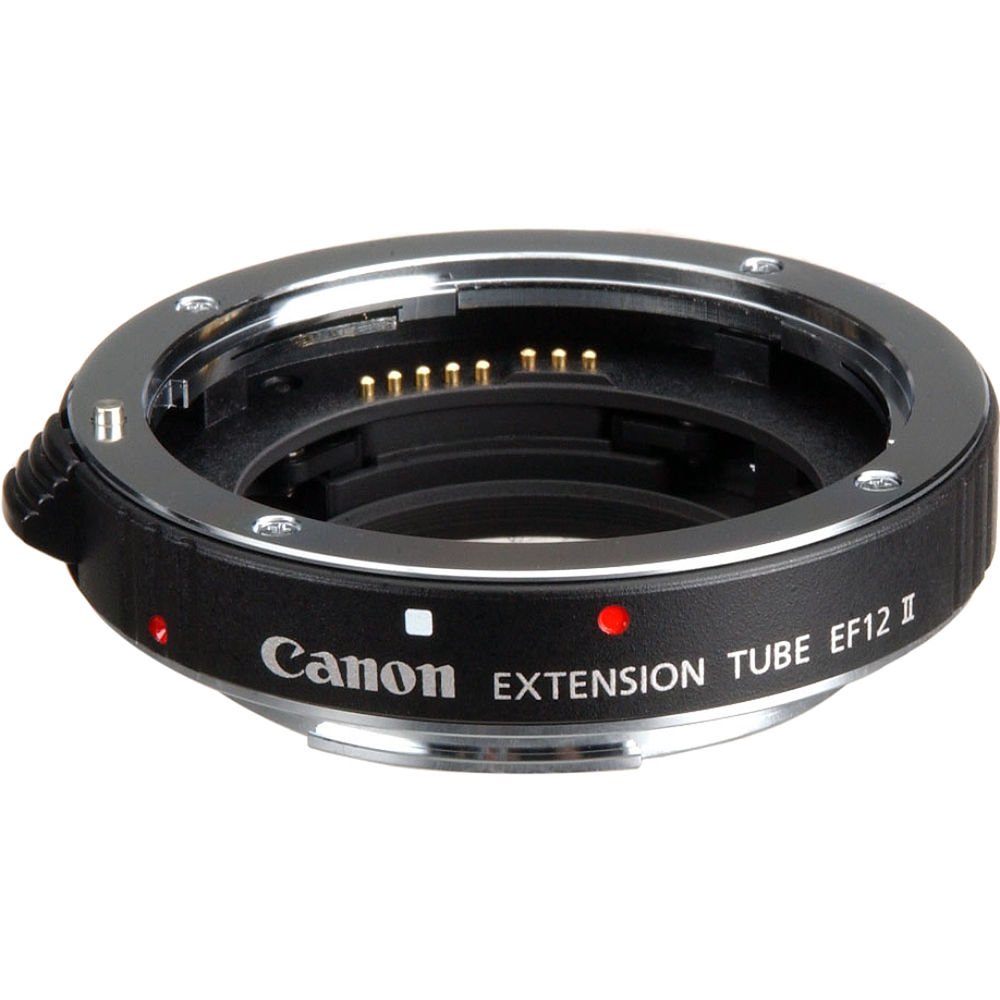
What are extension tubes?
Extension tubes, also known as macro tubes or macro rings, are hollow tubes of varying lengths that have bayonet or screw thread interfaces. They attach between the camera and the lens to enable close-up focus in macro photography. Macro rings do not have any optical elements. They are stackable and sometimes sold in sets that can be used combined or separate.
High-end models are made from aluminum and feature electronic contacts to facilitate auto-focus and aperture control with modern AF lenses. The mechanical connections between camera, lens and extension tube are rigid and secure. This allows for easy handheld work without further support, unlike other more cumbersome options like macro bellows.

How do extension tubes work?
Attaching an extension tube increases the flange focal distance, thus enabling the lens to focus closer than it’s normal minimum focus distance. This results in higher magnification that is often desirable in close up and macro photography. Extension tubes do not have any optical elements and do not affect the optical performance of a lens. However, as the rules of optics prevail, there are tradeoffs to be made – loss of light, depth of field and long-distance focusing. The longer the extension, the closer the lens can focus, but the amount of light and depth of field will be equally reduced.
The precise reduction of the amount of light reaching the imaging plane can be calculated using the inverse square law formula. For brand name extension tubes, these details are also sometimes posted by the manufacturers. If you are using auto exposure this is all done for you by the camera. The decreased light transmission can be compensated with longer exposure times, higher sensitivity, additional lighting or a combination of the above. Macro flashes are often used in conjunction with extension rings or macro lenses for this very reason.
Lens extension tubes and infinity focus
Loss of infinity and far focus distances is an unavoidable consequence of using extension tubes. In still photography, this does not usually pose a significant issue, as digital compositing can usually be easily employed if needed. For video production and cinematography, however, this is more difficult and time-consuming. In such scenarios, a careful balance between magnification and far-focus has to be chosen to achieve the desired output while minimizing post-production requirements. Sometimes, macro rings are paired with teleconverters to achieve just the right amount of magnification for a particular shot.
Decreased depth of field is a direct result of the decreased subject distance. It is one of the unavoidable tradeoffs we mentioned above. In still photography, this can be countered to some degree by using smaller apertures. Subsequently, this entails longer exposure or necessitates using more lighting. Very small apertures also introduce the risk of degraded image quality due to diffraction.
Compositing techniques, namely focus stacking, is another avenue to explore once faced with exceedingly shallow depth of field. Once again, due to the increased complexity of video post-production, aperture selection is usually the only practical method of depth of field control for motion picture users.

How to use lens extension tubes
You first need to establish that the extension tube/s, lens and camera you have are all compatible with each other before attempting to put them together. In this case, it means ensuring that the bayonet mount of all the components is the same. Attempting to assemble incompatible components can be disappointing or frustrating at the least, and can possibly lead to expensive optical or mechanical damages to the equipment.
As with any procedure that requires exposing the mirror box/sensor of a camera, it is advisable to be done carefully in a dry and dust-free environment. It would be prudent to blow the interior of the extension tube with a blower before mounting, as dust can migrate from there and get on your sensor, shutter or mirror. Once you have done that, it goes as follows:
- If you are stacking multiple extension tubes, mount them together first.
- Dismount the lens from the camera body if mounted and put on a body cap.
- Remove the rear cap of the lens (if it was not attached to a camera) and the front cap of the extension tube and mount them together.
- Remove the body cap and the extension tube rear cap and install the teleconverter/lens combo on the camera as usual.
Once the lens has been mounted and provided your extension tube/s support electronic lens control, your camera should behave exactly the same. However, you will quickly find that autofocus is largely irrelevant here and the effect your focus ring has is severely diminished. When working with large magnifications focusing is mostly done by physically moving the camera closer or further from the subject, for which a macro slider is very helpful. You might also notice that with such high magnification even small vibration or knock might result in blurry exposures or mis-composed images. To avoid this you might find a remote shutter release useful.
Different types of lens extension tubes
Due to the simplicity of the extension tube as a device, there is not much variation and you can get the same results out of virtually any set out there. There is, however, a single design variation significant enough to point out. It deals with the way extension tubes stack, and there are two main design approaches on the market.
Standalone extension tubes
The first design approach, generally preferred by higher-end manufacturers, is to make each separate extension tube with camera/lens bayonet at either end. One such example is the Canon EF12 II Extension tube pictured above. This construction allows each tube to be used on its own, as well as stacked. These tubes are sold individually, and you can even stack tubes made by different manufacturers, as they all should comply with the camera/lens manufacturer’s bayonet standard. Most good quality extension tubes of this type also incorporate contacts for electronic lens control. The main advantage of this approach is that each tube can be used separately. For example, if you have several cameras, lenses and tubes, you can have different setups assembled and ready to go.
Extension tube sets
The second type of extension tubes, usually reserved for the cheaper options, generally comes as a set of several tubes. One such set is pictured above as the Fotodiox Canon Macro Extension Tube Set. The bundle includes a camera mount ring, a lens mount ring and multiple tubes of varied lengths that go in between these two mounts. These components usually mount together using fine pitch thread, much like the one found on lens filters.
This setup is a bit more cumbersome to assemble and use, as you have to pay attention to the way different components come together. Due to the way these tubes stack, it is also impossible to incorporate electronic contacts. Because of this, they might not be an ideal solution for lenses with electronic aperture control, or for applications in which autofocus is needed.
Specifics by camera system
Almost all modern autofocus camera lenses feature electronic aperture control, and therefore lack manual aperture control rings. This means that in order for you to be able to control the aperture of the lens, it needs to be in electronic contact with the camera body. This is valid for practically all current still photography lenses by Canon, Sony, Nikon, Pentax, Sigma, Tamron, Tokina, Olympus, Panasonic, Hasselblad and Mamiya. Exceptions can be found in certain lines of Zeiss lenses (Milvus, Loxia), Leica’s M mount series and some Fujifilm lenses. Virtually all cinematography lenses, regardless of their mount, have mechanical aperture rings and function fully without electrical connection to the camera body.
Buying the right one/s
As discussed above, extension tubes are relatively simple devices. The absence of optical elements means that image quality is exactly the same regardless of the price and the brand of the tubes. As always, pricier sets do have advantages like better build quality and tighter tolerances. Most notably, though, what differentiates the basic and the more sophisticated versions is the presence of electrical contacts for lens control. If you are planning to use a modern electronically controlled lens that does not have an aperture ring this is essential. These lenses usually stay wide open when disconnected from the camera, severely limiting your control over exposure and depth of field.
Another thing to be aware of is build quality and fit. If buying a more budget-friendly set, make sure to read reviews and user feedback before purchase. Low-quality extension tubes might not mount or lock properly, which can result in jamming or detachment of the lens when you least expect it. When mounting a new extension tube always check whether the lock-pins in both the camera and the tube engage properly to prevent unwanted detachment.
Extension Tubes Q&A
Can I use extension tubes with a zoom lens?
Yes, extension tubes can be used with any lens – prime or zoom, long or wide-angle. As discussed above, however, some lenses are better suited to use with extension tubes than others.
What is the difference between a teleconverter and an extension tube?
While both devices look similar and are identically mounted between a lens and camera body, they are quite different in their functions. A teleconverter uses an optical element magnify the image the lens projects, effectively simulating a longer focal length. You can still focus at infinity with a teleconverter.
An extension tube, on the other hand, has no optical elements. In fact, it’s just a hollow tube. An extension tube simply increases the distance between the lens and the sensor or film, thus allowing the lens to be focused closer than it’s normal minimum. You cannot focus at infinity with an extension tube.
Do extension tubes reduce image quality?
Lens extension tubes have no optical elements, so they do not alter the quality of the image projected by the lens in any way. However, with an extension tube you are, put simply, taking a part of the image and stretching it. Doing this, you might start to observe lens defects that were not previously visible.






